In 1907, cotton broker John Rolston built the Rolston Hotel on 30 acres of land overlooking Portersville Bay. His family home, like so many others, had been destroyed in the September 1906 hurricane, which killed as many as 150 residents.
Coden’s desirability as a tourist destination had increased in 1899 when the Mobile and Bay Shore Railroad connected the rural area to Mobile. Riders of the train were offered a 75-cent roundtrip ticket and assured in period advertisements that “The Best of Order Will Be Maintained: No Intoxicating Liquors Will Be Allowed on the Train.”
After the storm, with the hotels and waterfront boarding houses gone, the number of train passengers sharply declined. Railroad officials approached John Rolston and convinced him to build a suitable hotel and even provided him with architectural plans.
The bayfront hotel stood three stories tall. An artesian spring on the property brought water to each pine-paneled room, which also featured gas lighting, a fireplace and a pair of iron bedsteads draped in mosquito netting. Rates for a room ran at $4 per day or $25 a week, including meals.
|
|
|
The hotel’s 100-foot-long wharf allowed guests to take advantage of breezes from Portersville Bay. The site of thehotel is now a park. |
Not surprisingly for a hotel that advertised “the saltiest bathing on the coast, ” a bathhouse on the property featured 26 showers. Overlooking the lawn and Bay beyond was an open pavilion where dance bands played on Saturday nights. Guests could enjoy the music as they strolled out onto the 10-foot-long wharf to catch the breezes.
The hotel was always popular with fishermen who could find tarpon, snapper and speckled trout in the adjoining waters. Boats and knowledgeable guides were available for hire.
The Rolston also advertised itself as “an ideal home-like resort” and assured patrons of their dining room’s “famous cuisine.” As roads improved, Mobilians would drive down on Sundays to pack that dining room for lunch. The bay breezes prompted more hotel advertisements to boast that it was “the coolest spot in the South.”
One chilly fall morning in 1927, a faulty fireplace sparked a blaze that reduced the rambling landmark to ashes. The family never rebuilt their bayfront pleasure palace, and the railroad which had inspired it would vanish after being reduced to only freight traffic.
More than 30 years after the fire, John Rolston’s son deeded 11 of the original 30 acres to the town of Bayou La Batre for use as a bayfront park. A historic marker has recently been installed at that park to remind visitors of the area’s early days as a tourist destination.
Have a question for Tom McGehee? Email [email protected].
text by Tom McGehee






